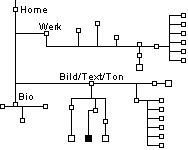In 1987, some three years later, Anna and I moved into a house-cum-studio in Celle, in the elbow of the tributary between the rivers Lachte and Aller. Not far from there, in a small village named Bargfeld, Arno Schmidt wrote his monumental novel »Zettels Traum« (»Zettel's Dream«). The author defined the location thus: »We are at the mouth of the narrow water, where 20 degrees, 20 minutes 50 seconds longitude east meets 52 degrees, 42 minutes 30 seconds northern latitude. Here, at this very point, the water pours into the Lutter. And to where does the Lutter flow? -- Into the Lachte. And the Lachte? -- Into the Aller. -- The latter flows, by Verden, into the Weser. It flows in turn into the North Sea. And so it goes on.« Anna Brenken pointed out this geographic connection in a feature she made for TV, emphasizing the word »Zettel« (»slip of paper«) to draw parallels between what Heinz Ohff termed Oppermann's »Kunst aus dem Zettelkasten« (»slip-box art«) and the creator of »Zettels Traum«. Anna had little sympathy for either Arno Schmidt's personality or narrative fiction, however, and always repudiated such imputations. Only after Schmidt's death in Celle in 1979 did she discover some similarities in the posthumously published theoretical text »Berechnungen III«, remarking that in her ensembles she was attempting, not unlike the author, to »display in visualized or articulated form various states of consciousness, planes of consciousness, reference systems (assessment spaces, meta-planes)«.
In a similar vein, critics have seldom neglected to point out the relationship between the art of Anna Oppermann and that of Kurt Schwitters, frequently describing her ensembles as collages transported into three-dimensional space, as sequels to the »Merzbau« (»merz building«). Again, Anna resolutely denied any connection, saying »the basic differences predominate«. The Sprengel Museum in Hanover now houses Anna Oppermann's large-scale ensemble »
The coincidences don't end there. At a symposium in Bonn in 1989, Anna met the Berlin-based art historian Ines Lindner, who invited her to participate in the forthcoming »Dialogues -- Aesthetic Practice in Women's Art and Science« project in Kiel. If Ines Lindner was surprised to find out that an invitation to visit Anna's studio entailed a trip to Celle, and not Hamburg as she had assumed, then Anna was no less astonished to learn that her visitor came from Celle, and since early childhood had been familiar with both the house and its inhabitants. The ensemble »
Five years after Anna's death, the ensemble now returns to Celle, the town where it was essentially produced, a place with which the artist was linked by more than »strange coincidences« of the Kleistian variety. However slight and incidental they seem, the influence exerted on her work by the coincidences was meaningful, after all.
[Übersetzung: Tom Morrison]
[
